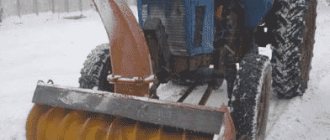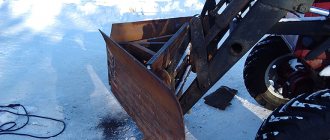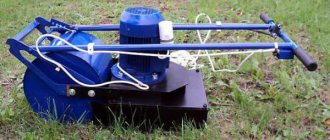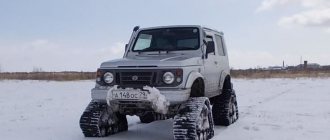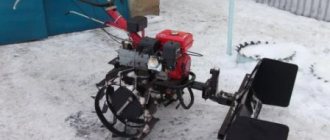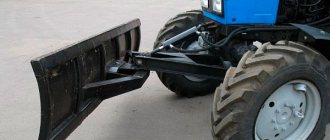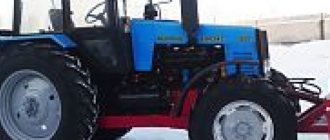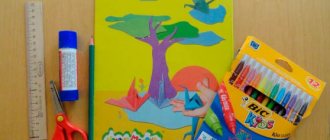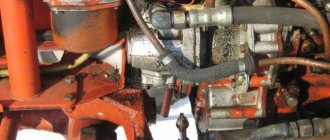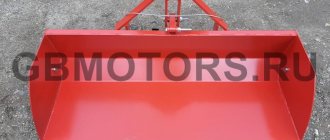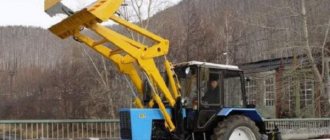How to make it yourself
To make a blade, you need tools and equipment that are available in every home workshop.
To work you will need:
- welding machine;
- Bulgarian;
- electric drill;
- roulette;
- square;
- durable knife;
- adjustable wrench;
- core;
- sandpaper;
- paint brush.
Necessary materials:
- steel barrel 200 l;
- 2 springs from UAZ or GAZ;
- profile pipe 20x40 mm;
- iron corners 30x30 mm;
- hardware (bolts, washers, nuts);
- car tire;
- acrylic paint.
To make a blade for an UAZ with your own hands, drawings should be prepared for 4 components of this product: an installation device, a subframe, a knife and a lifting mechanism.
The work sequence is as follows:
- Making a shovel. It is cut out of the barrel, half or a third of it is used. Along the perimeter and in the middle, the workpiece is reinforced with a steel angle, which is welded or screwed to it. The width of the shovel can be in the range of 100-200 cm, and the height - 40-80 cm. A knife made of a 100x20 mm steel strip or a cut tire is installed on the lower part.
- Installation kit. It can be central or frontal type. It is preferable to choose the second type, which is more durable and reliable and allows you to evenly distribute the load across the shovel frame. 2 brackets are made from a profile pipe with eyes for fastening. A rotation mechanism is provided.
- Stretcher. Made from durable metal. Designs are made of removable or stationary type. Removable mounts are attached to the bumper, while stationary mounts are rigidly screwed to the car frame.
- Lift. To adjust the height above the ground, a standard or separately purchased electric winch is used. A simpler solution is a manual winch, but you will have to leave the cab to lift it. The simplest option is to attach steel skis with level adjustment to the shovel.
After the individual components are manufactured, they are assembled and installed on the machine.
Making a rotary auger snow blower for a walk-behind tractor with your own hands
To independently manufacture a mounted homemade auger snow blower (auger rotor), you need to think about the placement of the main elements of the equipment, as well as link the dimensions to the existing walk-behind tractor. Therefore, first of all, a layout diagram of the device is created.
Necessary materials
To make an auger-rotary snow blower, you need to purchase:
- roofing galvanized sheet, it will be used for the manufacture of auger and rotor housings, as well as a snow ejection pipe with a deflector;
- an equal-field corner of 40 or 50 mm, it will be used to make the frame;
- a sheet of steel 2 mm thick, from which the auger and rotor blades will be cut;
- a profile pipe will be needed to make brackets;
- bearing housings and the bearings themselves for installing the shaft;
- a pipe or circle with an outer diameter of 30 millimeters or more will be used as shafts;
- pulleys, sprockets and other transmission elements;
- hardware for creating detachable connections.
Making a homemade auger-rotary snow blower
An approximate procedure for manufacturing a mounted auger rotor for snow removal:
- Parts of the auger body are cut from roofing sheet. They are bent according to a suitable cylinder. The frame of the auger body is welded from a rolled angle or profile pipe. The body and frame are connected into a single unit.
- Screw parts. To do this, segments are cut out of sheet steel, and then blades are formed from them. The auger shaft needs to be adjusted to accommodate the installation of bearings, so on a lathe the surface is machined to fit the fitting size of the supports, as well as transmission elements. The blades are welded to the shaft, forming an auger converging towards the center.
- The bearing housings and the bearings themselves are installed. The auger element of the snow blower is being assembled.
- The housing of the snow removal rotor is cut out of roofing sheet metal. Using suitable items, the final shaping of the rotor housing is carried out.
- Rotor parts. Rotor blades are cut from sheet steel. The rotor shaft is adjusted to accommodate the installation of bearings and transmission elements. The blades are welded to the rotor shaft.
- Balancing is necessary, since the rotor rotates at a fairly high speed.
- The frame of the rotor housing is welded from a corner or profile pipe. The bearing housings and the bearings themselves are installed. Assembly: the rotor assembly is assembled.
- A homemade frame is made on which the rotor and auger assembly will be placed.
- The working part of the machine is being assembled. Transmission elements are installed.
- Brackets are adjusted to connect the working tool to the walk-behind tractor.
- Bench tests are carried out, based on the results of which defects and shortcomings are determined. After eliminating the shortcomings, they begin testing the auger-rotor type snowblower under operating conditions.
All that remains is to use the manufactured rotary snow blower on the walk-behind tractor for its intended purpose.
Category: Attachments
We make the dump ourselves
Making a snow plow with your own hands is not difficult if you have a welding machine, a drill, a tape measure and a grinder on your farm.
Here is one simple version of this design for ATV owners. You won’t have to search for a suitable metal for a long time, since a regular 200-liter steel barrel is quite suitable for this. By carefully cutting it into 3 parts, we will get curved segments for a shovel. Weld two of them along the contour, and the resulting 3 mm thickness of the metal will be quite enough for rigidity.
The lower part of the blade needs to be reinforced with a knife. To do this, you will need a steel strip 5 mm thick and a length equal to the width of the scraper. You need to pre-drill holes in the knife with a diameter of 5-6 mm and a pitch of 10-12 cm to attach the safety rubber strip.
The most complex and critical parts of the entire structure are the mounting frame and subframe, which connect the blade to the ATV. Therefore, it is better to buy them so as not to have to laboriously take pictures of installation dimensions under the car. It is much easier to adapt a homemade snow plow to factory fasteners and this work can be done “on site”.
For a walk-behind tractor, the fastener design is much simpler and can easily be made in a home workshop. To do this, a 40x40 mm square pipe needs to be welded to a dump welded from two halves of a barrel for reinforcement. Then a thick steel semicircle with three holes is welded to the pipe, which are necessary to fix the angle of rotation of the shovel.
After this, an L-shaped holder is welded from the same pipe, one side of which is inserted into the mount on the blade, and the other is attached to the walk-behind tractor frame with bolts. To regulate the lifting height of the shovel, two bolts A and B are used. They are screwed into holes drilled in a piece of square pipe welded to the coupling device and placed on an L-shaped holder.
First fitting on the car
We adjust the blade directly in the field, there are no jibs yet (I found several photos of the manufacturing process), but the fastenings are already in place. You also need to maintain the parallelism of the blade relative to the hood so that the shovel does not become askew.
The blade should be on the same level as the Niva, in general it should be on the same level as the wheels (something like this)
Now the blade is attached to the Niva using the standard eyes, they just need to be modified a little, or rather, drill a hole for the bolts that will hold the entire structure through the silent block, which stands in the jet thrust. The blue arrow indicates the hole. I took them off for this purpose and painted them from a can for the occasion.
The Niva's eyes initially look like this, and are attached to one bolt, see photo (not mine), someone replaces them with a channel to secure the blade on it, I just welded another ear , the welding place is shown by blue arrows, red lines a square of metal (you can see it in the photo above), then drilled a through hole in them to insert a bolt.
How to make a dump on a Chevrolet Niva
It is better to place a wide washer under the head of the screw, otherwise there is a risk that it will be pressed into the shelf. Here is the final result of strengthening the rear shelf.
Looks normal from above. But not from below. It might be worth considering placing the screws symmetrically.
How to make a dump on a Chevrolet Niva with your own hands
Anyway. The channel parts sticking out from below the shelf will not tear things because everything there is made with curves. And this is just hooliganism at last.
What happens if you insert a wooden piece for furniture into a drill instead of a drill? Here's another interesting solution.
Snow plow for VAZ-2123 Chevrolet Niva
How to make a blade for a Chevrolet Niva with your own hands; description of making a shovel with the size and attaching it to the car. In this article I want to share another homemade product, we will talk about a dump on the Niva for removing snow from the local area and clearing roads Alexander NextUaz Topic author: At the bottom there is a rubber strip reinforced with sawing with a jigsaw.
The width of the blade is 2m, I don’t remember the height now, but it was about 70cm. Attachment to the car - welded to the amplifiers that are additionally installed on luxury trim levels, according to my calculations and concepts it should withstand.
There was an idea to make new amplifiers from a 50x50 profile and leave the factory ones alone and put them in the garage, but I just got lazy and it took a lot of time to make them. Yes, I almost forgot - I spent a very long time fiddling with the spacer bushings between the silent blocks, which I welded into the profile. While looking for a bushing, I came across some old nozzle from a Kamaz truck, the walls are thick, the diameter is less than the required one by some 1mm - I thought it was nonsense, I was wrong, I burned four drills on a drilling machine, not counting sharpening.
By the time the construction of the dump for the Niva was completed, there was not a lot of snow on the road, so it was not possible to carry out severe tests of the welded components of the dump on the Chevrolet Niva with our own hands, but later the weather pleased us, and snow fell every week. The blade showed itself to be excellent, the blade on the Chevrolet Niva was not modified by hand, it was the ability to lift it into the stowed position, if the Niva stalls with this miracle when cleaning the road, accidentally sliding into a ditch, then it is quite difficult to get out, you need to raise the blade, no matter what which didn't bother me.
The first mounting option for lifting the blade That's why the field itself was hastily modified, the stock bumper was removed, I'll still do the power ones, and in its place I stuck this device. It allows you to hang the blade in a stowed position, although for now you have to lift it manually, but this is only required to drive through impassable areas. Unfortunately, the photos are with a raised shovel for some reason. Video of the blade working Well, here’s a video of working with a blade on a Chevrolet Niva with your own hands, as you can see, the blade shovels quite a lot of snow, and is limited only by the Niva’s cross-country ability, so far the tires are ordinary, studded road tires, the Niva is not very passable on it, but this is enough for removing snow from the road.
There are cotton halogen lamps, how they shine is a separate issue; they shine over the blade onto the road, one closer, the other further away.
What not to do Now about why the blade had to be repaired, this nuance should be taken into account by absolutely everyone who wants to make a blade on the Niva with their own hands, the fact is that with short rods of the blade to the Niva, you risk getting such an embarrassment. Everything is fine with the car, a little wrinkled my skirt. Acceleration was in third gear. It turned out this way because the shorter rod on the right after the do-it-yourself repair on the Chevrolet Niva on the same day was slightly shortened.
The blade successfully served faithfully for several months, then during an impact this left link was broken off and welded literally 5 centimeters closer to the car, resulting in a short arm, and as a result, the blade went under the car.
In the photo above this is the minimum shoulder, its size is 60 cm, but it is better to make it larger to be sure that the blade will not turn down under the car in case of a strong impact.
Painting the dump The dump was restored in about three hours and partially painted. We're not expecting any more snow this year, so we didn't put it back on the car.
Blade painting
The dump was restored in three hours and partially painted. We're not expecting any more snow this year, so we didn't put it back on the car.
Dimensions of the Niva blade for snow removal
I took the dimensions of the blade after the fact, perhaps it will be useful to someone, the width of the blade is 2 meters, taking into account the fact that it is placed at an angle to the car in order to shovel the snow to the right, but if you do it straight, you simply push the snow forward (for example, push it out of yard), then do it according to the width of the Niva
Side view of the plow with dimensions, it pushes snow off the road to the right
View, if you look to the right of the car, the nearest curved tube, 60 cm in size, became like this as a result of a breakdown, it was bent like that, there is no need to bend it specifically.
The dimensions are given in the direction of travel, in a straight line.
I got these dimensions of the blade, I didn’t make any drawings before making the blade, I just did everything by eye, and then just measured it, maybe these dimensions will help someone imagine approximately what a do-it-yourself Niva blade should look like.
Ears for attaching the blade to the car
This is the eye for attaching the blade to the Niva in the end; I was able to bend it, so I left it as is.
- (1) - this is the factory eye
- (2) and (3) - I drilled for the bolt
- (4) - welded additional eye
- (5) - the bolt that holds the eyes is screwed into the Niva spar
After fitting the shovel to the machine, I added a few more jibs from a tube with a diameter of 20 mm, you can make them from the same profile pipe, I had the tube in stock. Blue arrows indicate the jibs, red arrows indicate where they are welded. It should be noted that I tried to attach them to the spring, because it is a shock absorber and shock absorber. Only the farthest one in the photo is attached to the rod itself, there was no possibility of attaching it to a spring, and the load is maximum there. without it, the right corner would have been turned over by a snowdrift.
Blade welding process
In this photo the blade is still short; another section has not been added; I welded it later.
Photo is clickable (click to enlarge)
The next step was to weld the springs (see photo below), in the hope that they would partially dampen the impacts of the blade on hard pieces, stones and ice, so as not to break the side members on the Niva; for this we will also have jet thrusts (more on them later ). I marked with green checkmarks where the spring is welded to the blade; each of them is attached to the blade frame in only two places.
From above, on the dump, springs 1 and 2 are welded through a loop in the photo, element 3, this ear from the same spring, was needed in order to increase the distance of the springs from the dump itself, since they lay too close to it.
Next, a profile pipe (1) 40x40 mm was welded to the springs, in places (2) and (3), I already welded the same tubes (4) and (5) to it, in fact these are rods going to the eyes of the cornfield , on this photo, on the left pipe you can also see a regular (round pipe), this is the result of repairing the blade, about which a little later.
I added an additional rod/jib/rack (1) to preliminarily fix the approximate position of these rods to the car itself (Niva). The arrows showed additional jibs , but they should not be done until everything is precisely adjusted directly on the Niva
Tools and materials
You can install a snow blade on the frame of any motorized cultivator that has a power of more than 4 hp. and weight not less than 50 kg. The heavier the unit, the better it will cope with the consequences of a snow storm. It is best to equip the domestic Neva walk-behind tractor with a shovel. This equipment has high performance characteristics and is adapted to work in the most severe weather conditions with maximum load.
A shovel for a walk-behind tractor is made with your own hands using the following devices:
- roulette;
- welding machine;
- grinder with discs for cutting and grinding metal;
- electric drill;
- set of wrenches;
- screwdriver;
- paint, paint brush.
After preparing the tool for work, it is necessary to decide on the material from which the shovel blade for the Neva walk-behind tractor will be made. You can make a shovel from various metal products that have a sufficient margin of safety.
The blade for the Neva walk-behind tractor can be assembled from the following materials:
An old gas cylinder. The thick walls of the cylinder are resistant to high mechanical loads. Having received such a blade, the walk-behind tractor will be able to cope with compacted snow, level roads, and move sand and crushed stone.
Barrels with a volume of 200 l. It should be taken into account that the walls of the barrel are made of thin steel. This shovel for the Neva walk-behind tractor can only be used for removing fresh snow that has not yet compacted and become covered with crust.
Metal strips. Bumpers from trucks or corrugated steel, which covers the floors of hangars and warehouses, are well suited for making a blade for a walk-behind tractor.
In order to make a rotating mechanism, you will need steel with a thickness of at least 10 mm. You can find such material at scrap metal collection points. The manufacture of fastenings involves the use of profile steel pipes 20x40 mm.
When working on loose and deep snow, homemade snow removal equipment can get stuck. This problem can be solved with the help of tracks installed on the axle shaft of the unit. A homemade tracked snow blower can work in any conditions, being as productive as special equipment.
Homemade attachments
The user can make a hitch on the mini tractor with his own hands. To do this, you will need design drawings that will indicate the parameters of the equipment being manufactured.
Before you begin assembling the KUN, you need to decide on the dimensions of the attachment and prepare the tools:
- metal profile (metal thickness depends on the type of proposed work);
- 3 hydraulic cylinders;
- swivel type connections;
- welding machine and gas cutter;
- wrench and wrench.
KUN manufacturing process:
- Cut the inner frame from two metal sheets.
- Make an arrow, where 70% of the length is a support that will connect to a large cylinder.
- Using hinges, attach the middle part to the base.
- Attach a bucket to the middle part (it is made from a prepared metal profile).
Bulldozer blade
In order to make such a homemade product for a mini tractor with your own hands, prepare the following tools:
- steel barrel;
- steel corner 10-15 mm;
- steel square 30 mm;
- 2 hinges;
- 3 hydraulic cylinders;
- fitting;
- hoses;
- transport tape (thickness 20 mm);
- rivets.
- Cut the top off the barrel, then cut it into 3 parts.
- Using pliers, bend all edges 3-5 mm.
- Make reinforcements from a corner (10-15 mm) and weld the slots. There should be 2 amplifiers at the edges, and the rest should be placed at a distance of 20 cm from each other.
- Weld a square along the entire frame from the bottom and top.
- Weld the braces.
- Install hydraulics between the corner and the square.
- Using hinges, hydraulic cylinders and angles, make a lifting and turning system.
The plow is made from a surface in the form of a cylinder (it is recommended to use steel to avoid bending of the blade). The workpiece is given the desired shape: it is fed to the rollers at an angle of 20-23°, bent, and then refined with a hammer according to the template.
A hitch is used to attach the hitch to the tractor.
The plow can also be made from a steel pipe, the diameter of which is 55-66 cm and the thickness is 4-5 mm.
A template is made from cardboard, applied to the pipe and outlined with chalk. The blade is cut out using gas welding and treated with emery. If necessary, modify the shape with a hammer. For attachment to tractor equipment, a rear linkage is used.
Blade manufacturing rules
The main rule that must be taken into account when drawing up homemade drawings is the correspondence between the scope of work and the power of the unit. Overload can lead to increased wear of components and mechanisms, their breakdown and failure of the machine.
When planning to make a blade for a walk-behind tractor with your own hands, you must adhere to the following criteria:
- Strength. The knife must have a sufficient resource to serve for at least 5 years. All its parts and mechanisms must be made based on the maximum permissible load and strong impacts.
- Dimensions. A homemade shovel should not be excessively wide or high. The optimal dimensions are considered to be width - 80-130 cm and height - 30-50 cm.
- Availability of a lifting mechanism. The blade for the walk-behind tractor can be raised hydraulically or using levers. This option allows you to remove snow from the yard or use the unit as a loader in the summer.
- Possibility of mounting a swivel joint. Using such devices, you can control the knives by tilting them up or down, right or left. Selecting the angle of attack allows you to better shovel snow and debris away from the path.
- Mandatory installation of a shock-absorbing strip made of dense rubber on the bottom of the bucket. This device is necessary to protect the walk-behind tractor from impacts, the bucket from deformation or breakage, and the road surface from mechanical damage.
- Quick installation and removal. Since the walk-behind tractor is a multifunctional device, all manipulations on its equipment must be carried out quickly and without the use of complex equipment.
The layout of the blade involves installing it on the front bracket, under the body or at the rear of the unit. The most optimal is the front location of the blade. This position provides the best quality cleaning.
The made bucket can have a horizontal or vertical orientation. The second option is chosen in cases where you have to work in cramped conditions.
Are there any significant differences between Russian and foreign plowing equipment?
If we compare plow snow removal equipment of the same class, then foreign devices do not have any significant differences After all, the blade itself is a slightly curved piece of steel that moves snow. Therefore, it cannot be improved or worsened.
The Russian hydraulic control, which is installed on such equipment, also does not differ in anything other than the price from the foreign one.
It is also in no way inferior in:
- quality;
- reliability.
The only difference can be if you are comparing a branded foreign blade and the products of some private workshop. If a Russian dump has a certificate of conformity, then it is no worse than foreign equipment.
Making a blade for Niva
The device consists of 5 main elements. First
— factory-made “kenguryatnik”, the only purchased part.
We install it on the “nose” of the car. In principle, you can weld your own if you find pipes of the required cross-section. The second element
is a cross member with mounting axles
(Fig. 1)
.
Cross member assembly. We press the axles into the pipe (ST-3;5) with a hammer to a length of 100 mm. On the axle, close to the pipe, we put washers on both sides, which we then weld to it. The axles must have 6 2.5 mm holes for pinning the nuts after they are installed.
We weld the finished crossbar to the “kenguryatnik”, additionally strengthening it with 4 corners 30×30 mm, 40 mm long.
Homemade dumps
Nowadays, many people prefer to live in their own homes, and accordingly the surrounding area occupies a large area. To work on a personal plot, motor cultivators, walk-behind tractors and mini-tractors are purchased.
In winter, snow removal turns into a competition to see who can beat whom. And owners who have motorized equipment prefer to remove snow with its help. Attachments for a walk-behind tractor are not cheap, so craftsmen prefer to make them themselves.
The domestically produced walk-behind tractor "Neva" is widely used. It has standard places for hanging devices and rubber wheels that are suitable for driving on loose snow. Most of the homemade dumps were made for the Neva.
On the Internet you can find many descriptions and drawings of a shovel for a walk-behind tractor with your own hands. But before manufacturing, you should familiarize yourself with the characteristics of the dumps. Product composition:
- executive (working) body;
- rotation mechanism;
- mounting bracket.
Rotation angles:
Turning the shovel to the side allows you to remove the snow mass while moving. By going to websites for amateur craftsmen, you can find a lot of information on how to make a blade for a walk-behind tractor with your own hands.
Blade from a cylinder
One of the available materials for making a dump is a gas cylinder. Its height is just over a meter, and the recommended shovel width is 1000 mm. Manufacturing work proceeds in the following sequence:
- Release excess pressure from the cylinder, if any.
- Trim both sides of the lid so that the width is equal to a meter.
- Cut the resulting pipe lengthwise into two halves
- Using a welding machine, connect these two halves so that the height of the blade is about 700 mm.
- The mounting bracket is made as follows. Cut a scarf from thick metal. Drill several holes in it to rotate the shovel in different directions. Weld a piece of pipe to the gusset.
- Weld the resulting device to the shovel at the height of the bracket on the walk-behind tractor.
- Installation is done using a thick finger.
The thickness of the cylinder is sufficient and no reinforcement is required. But the lower part can be equipped with dense rubber, which will remove loose snow and not spoil the compacted road. To do this, you need to take hard rubber from a rotary conveyor.
The width of the rubber sheet is 100−150 mm. Use an electric drill to drill holes in the blade to secure the rubber. To securely fasten the canvas you need a metal strip 900x100x3 mm. Drill holes in the strip and in the canvas, first marking them along the blade. Secure with bolts.
Sheet steel blade
Some craftsmen prefer to use new material rather than used elements. This way you can make a homemade dump shovel from a steel sheet 3 mm thick. To strengthen the structure, take strip steel with a thickness of at least 5 mm.
The material is cut according to the drawings. The blade of the shovel itself has four parts: frontal, lower and two side. The welded structure needs reinforcement. To do this, elements cut from the five are welded in the vertical direction.
Next, the rotating mechanism is manufactured. It is an ear with a hole for an axis. The ear is welded to a corner that is attached to the blade. The axis is fixed at one end of the pipe, and the other end is fixed to the walk-behind tractor. The required angle of rotation is fixed with a finger (dowel).
3 mm - the thickness is small, so reinforcement is required. Cut a strip of 850x100x3 from a 3 mm sheet. You can secure it with a bolted connection, but you will have to first drill or weld the strip.
As you can see, to carry out the work you will need:
- working material;
- grinder with discs;
- electric drill with drills;
- bolts with nuts;
- welding machine with electrodes;
- spanners;
- round or profile pipe.
If you have certain skills, the job is not difficult. And the resulting structure can be used not only in winter, but also in summer. Level the site after construction work, level out a place for a children's sandbox and much more. Which design to choose is up to you.
DIY blade drawings
Rice. 1
. Cross member 1 - pipe, 2 - axle (2 pcs.), 3,4 - washer (4 pcs.), 5 - hex nut (2 pcs.)
Rice. 2
. Thrust reaction rods 1,2 - horizontal and vertical pipes, 3 - washer (5 pcs.), 4 - bushing (2 pcs.), 5,6 - mounting plates to the blade (thickness 6 mm).
Rice. 2 a
. Horizontal pipe
Third element
— two thrust reaction rods
(Fig. 2)
.
The diameter of the horizontal pipe (Fig. 2 a)
is the same as that of the cross member. The dimensions of the bushings and washers of the left and right rods are the same. We weld the sleeve and washer to a horizontal pipe on an axis transversely, observing the axial seating size of the washers. We cut the opposite end of the pipe at an angle of 30 degrees, and weld the support plate for fastening 5 to the blade to the end. In the center we drill a hole d 10-12 mm for an M8 bolt. It is advisable that the hole be directed towards the outer edge of the blade for ease of removal and installation. We weld the lower end of the vertical pipe to the horizontal one. To the upper end, cut at an angle of 45 degrees, we weld the mounting plate 6 to the blade with two holes d 8 mm. When fixing a rod with a short horizontal pipe, we additionally install another washer 3 on the right axis of the cross member. Tighten the nut (key 36) until it stops and cotter it. We attach the long rod in the same way to the left side of the cross member.
Fourth element
— blade
(Fig. 3)
. Made of steel sheet. It has an inward bend to a depth of 100 mm. On the left side at the end we weld an amplifier (made of the same steel), on the inside - two amplifiers from a 30x30 mm square profile.
In the lower part we drill holes for attaching the transport rubber band (shock absorber) using bolts and washers. The protrusions of the tape beyond the blade are 50 mm.
Rice. 3
. Blade 1 - steel sheet 2000x800x4 mm, 2 - side reinforcement, 3 - internal reinforcements, 4 - transport tape (thickness 6 mm), 5 - holes for bolts (9 pcs.)
Fifth Element
— lifting and lowering device
(Fig. 4)
. We use a used jack, for example, from a VAZ-2108 (09). Remove the lower heel and the upper rubber pad. At the top we weld the lower split head of the connecting rod of the GAZ-24 engine.
In this article I want to share another homemade product, we will talk about a dump on the Niva for removing snow from the local area and clearing roads in the country, or rather in a cottage village under construction.
A Niva was bought for the dacha instead of an ATV (picking mushrooms for berries and going to the forest for brooms), having compared the prices of used ATVs and old Nivas, taking into account the fact that a quadric is not an all-weather vehicle and its price is twice the cost of a used Niva, not to mention already about the cost of spare parts. In general, Niva has all the advantages.
There are no detailed process of making a homemade blade in the photographs, since I cooked it in the winter in the evenings, and the photos did not turn out, so I will post what I already have, with the dimensions of the blade itself at the end of the article.
Features of manufacturing a snow plow
Let's consider another option for making a shovel, which is not too different from the previous one. For the blade itself you will need a 3 mm steel sheet, and for the racks that provide additional rigidity, you need to take thicker steel. It is necessary to make holes in the racks for attaching the shovel to the rods. It is very important to ensure vertical placement of homemade attachments in relation to the front of the power unit.
- shovel;
- rods;
- bracket for attaching the rods to the walk-behind tractor;
- craving.
Scheme of a walk-behind tractor with a blade
Why might a blade be useful?
An all-wheel drive vehicle can be used for more than just cross-country travel. Its performance characteristics are on par with those of tractors used by public utilities.
The snow blade on the UAZ is used for the following purposes:
- Planning of the local area, construction site, field and vegetable garden. The wheeled all-terrain vehicle generates enough torque to cut off the top layer of dense soil and move it over long distances. A machine equipped with a knife levels out bumps, fills holes, and makes the area even and smooth.
- Landscape design. Equipment equipped with a blade is used to dig out pools and ponds. The depth of the reservoir can reach several meters depending on its area. A homemade bulldozer is used to build alpine slides, embankments and artificial hills.
- Clearing the area of snowdrifts. A car with a shovel effectively clears snow up to 50 cm high. In a short time, passable equipment with a blade can tidy up a garden plot and driveways to a house. The entire area is cleared, or work is limited to areas, paths and paths. Snow moves to the fence or is removed from the site.
- Construction and repair of roads. In holiday villages this problem arises constantly. A UAZ with all-wheel drive can level the road surface, fill potholes, and clear ditches of debris. When moving forward, most of the work is done. When shifting to reverse gear, the final leveling occurs.
The mounted knife is also useful for field work. It is used to move cut trees and bushes, fertilizers and tops.
Why do you need a blade for a walk-behind tractor?
Using a blade you can perform the following basic work:
- clear snow drifts;
- level the surface of the earth;
- remove trash;
- perform loading operations (if the blade is in the form of a bucket).
A walk-behind tractor with such a hitch can also be used for:
- creating landscape design;
- construction of roads and paths;
- quick digging of trenches, wells and ravines;
- creating high beds;
- collecting bulk materials for their subsequent transportation in a cart (trailer);
- spreading soil or organic fertilizers around the site.
As can be seen from the list of works, the dump can be used all year round.
DIY blade drawings
Rice. 1
. Cross member 1 - pipe, 2 - axle (2 pcs.), 3,4 - washer (4 pcs.), 5 - hex nut (2 pcs.)
Rice. 2
. Thrust reaction rods 1,2 - horizontal and vertical pipes, 3 - washer (5 pcs.), 4 - bushing (2 pcs.), 5,6 - mounting plates to the blade (thickness 6 mm).
Rice. 2 a
. Horizontal pipe
Third element
— two thrust reaction rods
(Fig. 2)
.
The diameter of the horizontal pipe (Fig. 2 a)
is the same as that of the cross member. The dimensions of the bushings and washers of the left and right rods are the same. We weld the sleeve and washer to a horizontal pipe on an axis transversely, observing the axial seating size of the washers. We cut the opposite end of the pipe at an angle of 30 degrees, and weld the support plate for fastening 5 to the blade to the end. In the center we drill a hole d 10-12 mm for an M8 bolt. It is advisable that the hole be directed towards the outer edge of the blade for ease of removal and installation. We weld the lower end of the vertical pipe to the horizontal one. To the upper end, cut at an angle of 45 degrees, we weld the mounting plate 6 to the blade with two holes d 8 mm. When fixing a rod with a short horizontal pipe, we additionally install another washer 3 on the right axis of the cross member. Tighten the nut (key 36) until it stops and cotter it. We attach the long rod in the same way to the left side of the cross member.
Fourth element
— blade
(Fig. 3)
. Made of steel sheet. It has an inward bend to a depth of 100 mm. On the left side at the end we weld an amplifier (made of the same steel), on the inside - two amplifiers from a 30x30 mm square profile.
In the lower part we drill holes for attaching the transport rubber band (shock absorber) using bolts and washers. The protrusions of the tape beyond the blade are 50 mm.
Rice. 3
. Blade 1 - steel sheet 2000x800x4 mm, 2 - side reinforcement, 3 - internal reinforcements, 4 - transport tape (thickness 6 mm), 5 - holes for bolts (9 pcs.)
Fifth Element
— lifting and lowering device
(Fig. 4)
. We use a used jack, for example, from a VAZ-2108 (09). Remove the lower heel and the upper rubber pad. At the top we weld the lower split head of the connecting rod of the GAZ-24 engine.
With modern technology, manual snow removal over a large area is becoming a rare occurrence.
Indeed, why spend long hours and effort clearing snowdrifts from your estate, yard or street when there is a powerful SUV, ATV or walk-behind tractor in the garage?
A snow blade, which can be easily attached to these types of equipment, significantly speeds up and facilitates the cleaning process.
In addition to dozens of ready-made structures that can be purchased on the attachment market, such a “grader” can be made with your own hands with minimal costs of materials.
All snow plows, depending on the type of equipment with which they are aggregated, are divided into several groups. Let's take a closer look at these devices in order to better understand the design features and correctly evaluate their performance and price parameters.
Single blade snow plow
Snow plows are the simplest and cheapest, as well as the least metal-intensive working tools for snow removal. They have become widespread due to their ease of manufacture and mounting system on the base machine. The blade of such a snow plow is made in the form of a solid sheet, fixed in working position and can move snow only in one direction. These plows have a larger capacity: the average snow plow has a larger capacity than a snow bucket.
It should be noted that some companies produce attachments only for their own equipment, while others produce universal blades for equipment of different brands.
Caterpillar offers
Thus, 11 models of snow plows are produced with a width from 1.8 to 4.3 m, capable of turning in both directions at an angle of up to 30°. Also available are two V-blade models with independently rotating wings and two rotating box models in 2.4m and 2.8m widths.
Snowblowers can be equipped with Automated Blade Assist, which automatically maintains a preset blade angle, reducing operator workload during operation.
It is recommended to use them for removing large masses and thick layers of snow in large, open spaces: highways, parking lots, etc. Practical recommendation: Douse a steel dump with water at sub-zero temperatures to form a layer of smooth ice on it. This will allow the snow to slide better over the surface of the dump. Blades can shovel snow into higher piles than snow buckets. Therefore, plows are recommended for use in areas where there is little space for storing snow.
JSC "Velikoluksky (Velikie Luki, Pskov region) produces snow plows for KDM: a high-speed blade with a wing height of no more than 1400 mm, two main quick-release front blades with a blade width of 3500 mm and two urban quick-detachable front blades with a blade width of 3000 mm.
All blades copy the road surface in the longitudinal and transverse axes and remove snow without the effect of piling onto the cabin.
Main and city dumps are equipped with rubber and metal knives and, using a hydraulic drive, are rotated in both directions up to 40°.
To expand the snow clearing lane, increase the range of snow throwing when the snow plow is moving at high speed, shift and level snow banks along the edges of the road, in addition to the main blade, an additional plow, called a “wing,” right or left, can be installed on the side of the snowplow machine.
The Kemerovo Experimental Mechanical Repair Plant ( DMK KORMZ , Kemerovo) produces a line of front, side and middle snow plows for cleaning snow plows in patrol mode. In particular, the OBA side blade provides the machine with a working width of up to 4.6 m, is capable of changing the working angle (from the transverse axis) from 5 to 43°, and operates at speeds of up to 60 km/h.
Medium dumps (OSA brand) are equipped with an additional retractable wing, which allows you to increase the width of the dump from 2.45 to 2.9 m, and special knives that allow you to develop ice and run-up without reducing speed. The height adjustment mechanism allows you to change the cutting angle of the knife.
Snow plows also have a disadvantage or, rather, a limitation in use. They push and shovel snow, but they cannot lift masses of snow from the surface and load them onto vehicles.
Like earthmoving plows, snow plows have knives (cutting edges) that are often reversible so they can be flipped the other way around. Blades are often shaped like a comb to loosen compacted snow and ice. Most modern snow plows are equipped with an obstacle protection system. When the blade blade hits an obstacle, the blade folds back, after overcoming it returns to its original position, and then continues to clear the surfaces of snow.
Case produces a snow plow for its road construction equipment with a blade consisting of two sections, which allows the blade to “jump” over uneven surfaces up to 230 mm high on the surface being cleared . Using a hydraulic drive, the blade can be rotated up to 35° left and right.
Case also offers a butterfly snow plow that can jump over obstacles via suspension and can swivel ±35° left/right. The range is complemented by a whole line of six box-shaped blades, the sections of which can move independently of one another. The dumps are equipped with knives made of Hardox 450 steel.
Protection against damage is also provided by rubber pads (scrapers), which soften impacts on objects invisible in the snow or surface unevenness and are easily replaced in case of wear and damage. When choosing scrapers, keep in mind: the softer and more elastic the rubber, the smoother the movement of the blade and the entire machine will be.
Lipetsk Plant of Small Municipal Machines LLC (LZMKM LLC ) produces the OP-2000 utility rotary blade (deflection angles ±30°), which is equipped with an original compacted snow ripper in the form of a shaft made of stacked toothed disks. The ripper design is patented by LZMKM and works very efficiently without damaging the hard surface of sidewalks and roads. The DKO-2000 Butterfly blade with movable sections and hydraulic drive is also produced.
Blades are also equipped with supporting devices: skis (shoes) made of hardened steel or rollers (wheels), with their help the height of the blade position during operation is adjusted, that is, the contour of the surface being cleaned is copied.
JCB offers a 5-position snow blade for its road construction machines that can be hydraulically rotated 25° to the right/left . A rubber wear pad protects the blade from bumps, and a jockey wheel helps the blade follow the contours of the surface.
The Finnish company Arctic Machine Oy has been supplying snow removal machines and equipment to Russia for many years; the production of some of them is localized in the country. The company offers a whole range of front, middle and side blades for high-speed cleaning of highways. By the way, Arctic Machine was the first to supply side dumps to Russia.
The high quality, performance and reliability of Arctic Machine dumps fully justifies their higher price compared to domestic dumps. Also, Arctic Machine dumps are heavier than many domestic ones, due to which they better copy the topography of the surface being cleaned. The mechanism that ensures vertical movements of the blade is equipped with reliable bronze bearings.
Arctic Machine dumps are equipped with original supports in the form of plates made of anti-wear steel with carbide plates soldered to them. Together with carbide blades, one set of such support plates can work for a whole season when working on a highway with asphalt concrete pavement.
There are fixed and rotary blades.
Rotary blades. GOST 15840–70: rotary blade of a snow plow - blade of a snow plow with a variable grip angle. The turning mechanism can be mechanical (with manual adjustment) or more modern and convenient - hydraulic, where turns are performed by two hydraulic cylinders. To install a blade with hydraulic rotation, the machine must have additional hydraulic connections.
Ferronordic Machines LLC (Khimki, Moscow region) is the official dealer of Volvo Construction Equipment . The company offers snow plows for Volvo skid steers with mechanical or hydraulic 30° left and right rotation for more efficient snow removal. A rubber edge is installed on the dumps.
The range also includes a V-shaped rotary snow blade for Volvo mini loaders. The blade has hydraulically operated swivel wings and replaceable bolt-on blades. When hitting an obstacle, the blade tilts forward to reduce damage to both the blade and the obstacle. A tipping lock is available for reliable snow dozing.
The rotary blade increases the maneuverability of the machine; it can be used both in small areas and in large open areas; it is convenient for them to remove snow around obstacles and curbs.
Sectional dumps , as the name suggests, consist of separate sections, the angles between which can vary. This design provides a number of advantages.
Road cleaning equipment of the AEBI-SCHMIDT Group (ASH) is well known in our country. In the SCHMIDT product line there are two series of multi-section snow plows: CIRRON - from 2.4 to 4 m long and consisting of 3-5 sections, as well as TARRON, especially strong and reliable, from 2.7 to 4 m long and consisting of 3 –4 sections.
In addition, SCHMIDT's product range includes single-section rotary blades made of steel and plastic, wedge-shaped blades, special blades made of high-strength Swedish steel, side blades, etc.
For example, such blades can remove snow from surfaces with complex profiles - slopes, rises; depending on the thickness of the snow cover and the speed of the machine, the angle between the sections can be adjusted; individual sections can be raised to pass over obstacles hidden under the snow.
How to secure
The fastening device is the most complex and critical part of the entire blade design. The shovel is mounted on the frame using brackets made from straightened springs or profile pipes. It should be borne in mind that such a factory-made mechanism can cost 10,000 rubles or more. Therefore, it is advisable to do it yourself and spend the saved money on purchasing components.
A simple option is the central holder, which is assembled in the following sequence:
- Welding a profile pipe to the back of the shovel.
- Fastening a semicircle made of steel sheet to a stiffener rib.
- Drilling holes in a semicircle.
- Making an L-shaped holder.
- Attaching the holder to the semicircular base with a central swivel bolt.
- Attaching the device to the car frame.
Adjusting the angle of the bucket is done by removing the locking bolt, turning the blade in the desired direction until the holes line up, and re-tightening the bolt and nut. To reduce the impact force on hard objects and bumps on the ground, an adapter with a short and stiff spring is inserted into the holder.
Attaching the bucket to the walk-behind tractor
As a rule, all motor cultivators have a standard bracket for attaching attachments. It is quite suitable for attaching a front blade. If necessary, an adapter is made to allow the bucket to be rotated to the right or left.
The fastening is made in this way:
- A profile pipe is welded from the back of the bucket. To ensure secure fixation, it is advisable to duplicate the welding seam with several bolts.
- A semicircle with a diameter of 20-25 cm is cut out of sheet metal 10 mm thick. The workpiece is welded to the profile pipe. Holes are made along the edge at intervals of 20 mm to adjust the angle of the bucket.
- A holder in the shape of the letter “L” is made from a square pipe. The short side of the holder is fixed to the rotary sector, the second end is rigidly fixed to the bracket of the walk-behind tractor. To adjust the height of the knife, bolts screwed into the adapter are used.
A simpler connection method is a system of lugs and clamps made of thick sheet steel.
ATV plows
High maneuverability, combined with high traction force and powerful lugs, make a regular ATV an excellent base for installing a snow shovel.
The blade selection process includes four stages. First you need to decide on the installation kit - a structure that is attached to the frame and depends on the ATV model. Then a subframe is selected, after which all that remains is to select a suitable blade for it and a mechanism for lifting it.
There are two types of installation kits - front and central. The first ones are designed to be connected to the front base of an ATV and are intended for vehicles with low ground clearance. The advantage of the second type is to increase the rigidity of the tractor frame and improve the stability of its movement when clearing snow.
The blade mount is designed in such a way that it does not reduce ground clearance or reduce the vehicle's maneuverability.
The width of a snow shovel for an ATV depends on the engine power, the weight of the machine and ranges from 125 to 150 cm.
Inexpensive snow shovels that do not have a lifting mechanism are equipped with “skis” - a special sliding device that maintains a safe gap between the shovel blade and the surface of the coating.
The highest quality, but also the most expensive, blade systems for mounting on ATVs are produced by the American company Warn. A set consisting of a straight shovel, an installation kit and a frontal base along with lifting and turning mechanisms will cost the buyer 59,000 rubles. For comparison, prices for similar equipment from the Russian company Atvstar, but not equipped with a shovel drive, range from 15 to 20 thousand rubles.
An ATV with a mounted shovel can only be used effectively on loose snow no more than 50 cm high and not compacted into dense layers.
conclusions
Snow plows are designed to clear roads of shallow, fresh snow, so installing them turns any tractor or heavy dump truck into a snowblower.
At the same time, the cost of the blade and its installation will be 10–15 times less than that of a snowplow equipped with such a device. After all, after the snow melts, the blade is removed and the tractor or truck continues to work all year round , and does not stand idle until the beginning of next winter.
In this video you can see. how the speed blade works:
